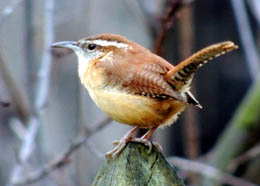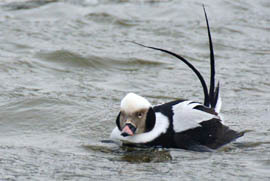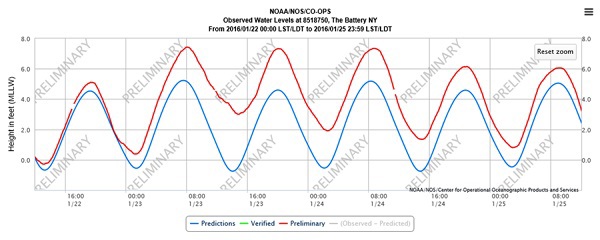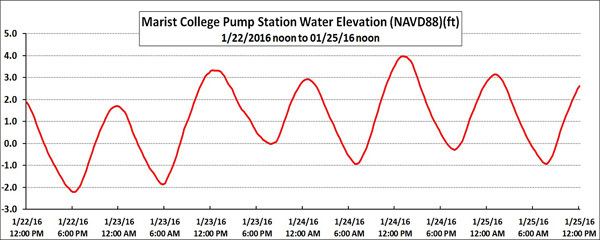Hudson River Almanac 1/18/16 - 1/24/16
The New York State Department of Environmental Conservation sent this bulletin on 01/29/2016 04:56 PM EST |
| DEC Delivers - Information to keep you connected and informed from the NYS Department of Environmental Conservation |
| Share or view as a web page || Update preferences or unsubscribe |
|
|
|
OVERVIEW A record-setting coastal blizzard hit New York City and the lower estuary this week, while much of the rest of the watershed saw little or no snow. Our Hudson River gray seal, now free for 39 days, continued to travel the ocean waters off New England. HIGHLIGHT OF THE WEEK 1/23 - Manhattan, HRM 5: Central Park received 26.8 inches of snow, the second heaviest snowfall ever recorded, exceeded only – and barely – by 26.9 inches there on February 12, 2006. Elsewhere in New York City, Staten Island received 31.3 and areas of Queens received 34 inches of snow. NATURAL HISTORY NOTES 1/18 - Newcomb to Minerva, HRM 302-284: On a two-day tour with birders from Connecticut over the Martin Luther King holiday weekend, we spent our time in the boreal habitat of Long Lake, Newcomb, and Minerva. Among the highlights were a flock of 28 Bohemian waxwings in Long Lake, four black-backed woodpeckers, 13 gray jays, five boreal chickadees, 14 red crossbills, and more than 80 evening grosbeaks across the two days. 1/18 - Town of Poughkeepsie: The adult female (banded N42) in eagle nest NY62 came to the nest today with a snack (unidentifiable). Later she joined the male (not banded) in a tulip tree, perching close together. After a while he seemed to decide to take advantage of the thermals and soared up and up and up and out toward the river. [Bringing food to the nest will cease once eggs are laid and incubation begins. It pays not to advertise to the raccoons that there is food up in the nest tree. Tom Lake.] 1/18 - North Atlantic: This was Day 39 at sea for Charlie the Gray Seal, rescued from the Hudson River in Saratoga County by The Riverhead Foundation for Marine Research and Preservation on December 4, and then released back into the ocean on December 10, at Hampton Bays, Long Island. After spending 35 days in Cape Cod Bay, Charlie left back through the Cape Cod Canal. His first stop was Martha’s Vineyard; then he headed out to the open sea off Rhode Island before doubling back to Nantucket Island, Massachusetts. Charlie has been tracked by a tiny satellite tag, number 150975, that he carries on his back. His travels over the last six weeks have provided valuable behavioral information to the biologists at The Riverhead Foundation. 1/19 - Town of Poughkeepsie: I was looking for the bald eagles in nest NY62 in midday when a red fox appeared, frolicking and hunting in the field north of the nest. He spotted me and quickly changed his direction, moving farther away and finally running into the woods. 1/19 - Brooklyn, New York City: I spotted and photographed a first-winter California gull in a parking lot at Gravesend Bay. The single photo was posted on Facebook in both the North American Gulls group as well as Brooklyn Urban Birders. From those who have viewed the photo we have received many affirmatives for the bird from major sources such as Amar Ayvash. [The California gull (Larus californicus) is a bird of the mid-west and western United States (it is the state bird of Utah), and rarely appears in the East. Tom Lake.] 1/20 - Newcomb, HRM 302: We have had a slow beginning to winter, so far receiving only about 17 inches of snow with nine inches of snow cover presently on the ground. There was also a 4-5-inch layer of ice at the bottom of the snow pack, something that is not advantageous for our little critters like mice and voles. The lack of snow combined with the cold temperatures is likely a detriment for other animals that depend on the snow for insulation such as bears and chipmunks. The river still had open water and despite some chilly temperatures, has not completely frozen over. The bay at the Route 28N bridge was frozen and the ice was sturdy enough for some intrepid ice fishermen. Some winter birds have been in abundance, including evening grosbeaks, pine siskins, Bohemian waxwings, red crossbills, and purple finches. In contrast, I had a red-winged blackbird that seemed determined to spend its winter in Newcomb. 1/20 - Eastern Dutchess County: This was another exciting day for eagles. An adult bald eagle was calling as it perched atop a tree and, as I watched, a large dark bird, which I figured was an immature, flew past. After a closer look I realized it was an immature golden eagle. It seemed like the golden was trying to annoy the adult bald eagle by circling around its perch. Soon, however, a crow joined the golden eagle, flying right next to it, even bumping the larger bird. The golden soon left with the crow in pursuit. 1/20 - Town of Poughkeepsie: While several of us (The Soul of NY62) monitor the bald eagle nest, it takes patience and persistence to be there for special occurrences. One such event happened today: Mom left the nest tree and later came right back with an American eel. The last of the eel did not go down easy but eventually she got it swallowed. The lack of ice on the river this winter is likely making it much easier for eagles to procure food. 1/20 - Verplanck, HRM 40.5: With the strong winds significantly subsiding, we decided to venture out in search of eagles. At the Veterans’ Park in Verplanck, we spotted a pair of eagles across the river, perched side-by-side high up in a hardwood tree at Stony Point - a mated pair. Two double-crested cormorants rested on the channel marker while others flew past. 1/21 - Hudson Falls to Waterford, HRM 205-159: We surveyed this stretch of the Hudson River for the New York State Winter Waterfowl Count. Three of us covered the roughly 46 mile reach. Ice coverage decreased from north to south and there was much more open water than in a typical year; perhaps 50 percent of the river remained open below Fort Miller. Ten species were recorded, along with four adult bald eagles. The highlights were a single snow goose with 4,100 Canada geese just above the Stillwater Bridge, and a female long-tailed duck at the Fenimore Bridge in Hudson Falls. 1/21 - Stillwater, HRM 171.5: Despite some new ice on the Hudson River, the only addition to the waterfowl list for our Thursday Birders group was a single ring-necked duck in Stillwater. There were many thousands of Canada geese in fields on the Rensselaer County side; they moved into the water by the time we got there, but there were no rarities among them. 1/21 - Greene County, HRM 112: It was 9:00 PM and I was almost home in West Kill when an unusually large, shaggy yellowy-gray coyote crossed the road in front of my truck. At first glimpse I thought it was a white-tailed deer. It seemed like it was practically at eye level with me, but I know from measuring my own hounds that it couldn't have been more than 60-65 pounds. Still, we do occasionally have them that big around here. The largest I’ve seen personally weighed 72 pounds. Most of my trapper friends call them “eastern brush wolves.” [This was an eastern coyote, a variety of coyote that grows to a larger size and often has darker fur than is generally associated with the species. Two separate teams of researchers studying the genes of coyotes in the Northeast reported evidence that these animals, for decades thought of as coyotes, are in fact coyote-wolf hybrids, carrying both wolf and coyote DNA. The findings may explain why coyotes in the East are generally larger than their Western counterparts - that is, more wolf-like in size – and why they are so much more varied in coat color, as might be expected from a creature with a more diverse genome. As a result, we coyotes “fans” like to refer to them as “Woyotes.” Tom Lake.] 1/21 - Town of Poughkeepsie: The behavior of the adult bald eagle pair in nest NY62 continues to suggest mating season is near. Today two eagles shared one space in an intimate “cuddle.” 1/22 - Delmar, HRM 143: We caught the late afternoon “circus” today at the Five Rivers Environmental Center, including at least six harriers (two males). Returning to the parking lot, we checked the owl hole but did not find the usual red-phase screech owl. Instead it was replaced by a gray screech owl. Baby owls on the way? [In the northern harrier’s binomial scientific name, the genus is Circus. Tom Lake.] 1/22 - Greene County, HRM 118: Driving home on Route 42 late this evening, a young black bear, maybe 60-70 pounds, crossed in front of my truck. Although it was moving rapidly, I could not imagine what it was doing out on a cold January night (15 degrees Fahrenheit). 1/22 - Millbrook, HRM 82: Twilight came early. In advance of an intense winter storm, the clouds had lowered and shut off the sky. At least three flocks of high-flyer geese passed over - Canadas by their call. Although we could not see them, we traced their flight by sound from north to south before they faded away. 1/22 - Town of Poughkeepsie: Out of nowhere, both adults from eagle nest NY62 showed up and circled once before heading in opposite directions. A few minutes later, Mama returned with a wad of grass and sat in the nest rearranging it. Later, Dad returned with a stick and placed it in the nest as well. We noted this same activity last year on February 16 and 19, as well as at other times. It was really good to see both of them working on the nest together. 1/22 - Staten Island, New York City: Shortly before 4:00 this afternoon, I found an adult mew gull (most likely common gull) at Fort Wadsworth on Staten Island. The bird was feeding off a jetty with a large flock of ring-billed and Bonaparte's gulls. [The mew gull and the common gull are the same species (Larus canus). The species has a nearly circumpolar breeding range in Eurasia and northwestern North America, and it wanders to our Atlantic Coast. European field guides refer to it as the common gull; North American field guides tend to use the name mew gull. Tom Lake.]
1/23 - Delmar, HRM 143: I checked the owl hole again today at the Five River Environmental Center and found that yesterday’s gray screech owl had been replaced by the red-phase bird. I’m betting it is a mated pair. 1/23 - Poughkeepsie, HRM 75: I found a male long-tailed duck diving in the river offshore from Waryas Park. I wondered if the blizzard along the coast had pushed the duck upriver. [Photo of long-tailed duck courtesy of Maha Katnani.]
1/23 - Chelsea (Low Point), HRM 65.2: It was one minute until midnight, high tide, full moon and not a cloud in the sky, but the anticipated storm surge from the record-setting blizzard along the coast never appeared. A strong north wind gusting well over 20 mph may have contributed in blunting the rise of the river. As I waited, and listened, I wondered if there was anything more haunting than the sound of a bitter cold winter wind blowing through conifers. [As seen on this graph from the National Oceanic and Atmospheric Administration tide gauge at the Battery (the southern tip of Manhattan), storm surge associated with the blizzard peaked 4.3 feet above the predicted water level just before low tide at about 1:30 p.m. By the time of the evening high tide, surge was less – about 2.75 feet above predicted water levels [predicted water levels do not take meteorological conditions into account].
In the evening surge was reduced as the winds shifted to come from the north rather than the northeast, lowering water levels along the coast. The surge did travel up the Hudson; note the similarity in the pattern of water levels (shifted a few hours later) recorded by the Hudson River Environmental Conditions Observing System station at Poughkeepsie. Steve Stanne.]
1/23 - Crugers, HRM 39: The first snowfall of the season arrived last night and our yard was a beautiful sight to behold this morning, peaceful and serene, with large flakes of softly blowing snow. What made it even more special was the influx of about 30 red-winged blackbirds. The blackbirds were mostly ground feeding and our heated birdbath was a welcome treat for these birds as well as cardinals, white-breasted nuthatches, downy woodpeckers, chickadees, sparrows, and juncos. 1/24 - Montgomery County, HRM 157: We made a survey of Montgomery County today, beginning at Lock 15 on the Mohawk River where the previously reported red-necked grebe was still present, along with a couple of common mergansers, a load of Canada geese, one snow goose, and two or three bald eagles. Sparrows were well represented on the roadsides with the American tree sparrow particularly abundant, but also good numbers of white-throated and lesser numbers of song sparrows and savannah sparrows. One large, manured field held hundreds of snow buntings and horned larks. 1/24 - Green Island, HRM 153: The red-breasted merganser continued to reside in the Hudson River at the head of tide, along with many common mergansers and a female bufflehead. 1/24 - Poughkeepsie, HRM 75: I saw a duck fly in from the north and land in an open area of the river in front of me near the shore. It was the long-tailed duck reported yesterday. I watched as it actively dived among the Canada geese and ice floes and was then carried north again by the fast moving current of the flood tide. 1/24 - Town of Fishkill, HRM 63: A cloud of starlings just blew into the neighborhood and took over the two heated birdbaths, displacing all the sparrows. The starlings numbered 150-200 birds and, after a bath and a drink, jumped on the apple tree and feasted on fermented apples. I checked and listened but there were no blackbirds mixed in with those noisy starlings. I've been surprised this season that no starlings had been harassing the regulars at my bird feeders - not a one. WINTER 2016 NATURAL HISTORY PROGRAMS Thursday. February 4: 6:00 p.m. Saturday, February 6: 9:00 a.m. - 4:00 p.m.(bad weather date February 7) Saturday, February 13: 2:00 p.m. HUDSON RIVER MILES The Hudson is measured north from Hudson River Mile 0 at the Battery at the southern tip of Manhattan. The George Washington Bridge is at HRM 12, the Tappan Zee 28, Bear Mountain 47, Beacon-Newburgh 62, Mid-Hudson 75, Kingston-Rhinecliff 95, Rip Van Winkle 114, and the Federal Dam at Troy, the head of tidewater, at 153. The tidal section of the Hudson constitutes a bit less than half the total distance – 315 miles – from Lake Tear of the Clouds to the Battery. Entries from points east and west in the watershed reference the corresponding river mile on the mainstem. TO CONTRIBUTE YOUR OBSERVATIONS OR TO SUBSCRIBE Smartphone app available for New York outdoor enthusiasts! Copies of past issues of the Hudson River Almanac, Volumes II-VIII, are available for purchase from the publisher, Purple Mountain Press, (800) 325-2665, or email purple@catskill.net |


 1/23 - Clifton Park, HRM 157: Last year during a real cold spell, a pair of Carolina wrens had a night roost between my townhouse and a large snow bank. There is an overhang and a southern exposure. One wren would snag something from the feeder, fly directly at the window, and at the last minute shoot between the house and the snow. I was really worried for them. But they are back this year with two others. They had been around all summer but recently I have seen more of them checking out the bird feeder. [Photo of Carolina wren courtesy of Debbie DiBattista.]
1/23 - Clifton Park, HRM 157: Last year during a real cold spell, a pair of Carolina wrens had a night roost between my townhouse and a large snow bank. There is an overhang and a southern exposure. One wren would snag something from the feeder, fly directly at the window, and at the last minute shoot between the house and the snow. I was really worried for them. But they are back this year with two others. They had been around all summer but recently I have seen more of them checking out the bird feeder. [Photo of Carolina wren courtesy of Debbie DiBattista.] [The long-tailed duck (Clangula hyemalis) in uncommon in the watershed. They breed in tundra pools and marshes and in large mountain lakes. They are migratory and winter along the east coast of North America and on the Great Lakes. The former common name for long-tailed duck was oldsquaw. Although that name is still found in old field guides, it was dropped from common usage in favor of long-tailed duck more than a decade ago. This was done for several reasons, among which was the negative connotation of the English word and its offensive reference to Native Americans. Tom Lake.]
[The long-tailed duck (Clangula hyemalis) in uncommon in the watershed. They breed in tundra pools and marshes and in large mountain lakes. They are migratory and winter along the east coast of North America and on the Great Lakes. The former common name for long-tailed duck was oldsquaw. Although that name is still found in old field guides, it was dropped from common usage in favor of long-tailed duck more than a decade ago. This was done for several reasons, among which was the negative connotation of the English word and its offensive reference to Native Americans. Tom Lake.]
